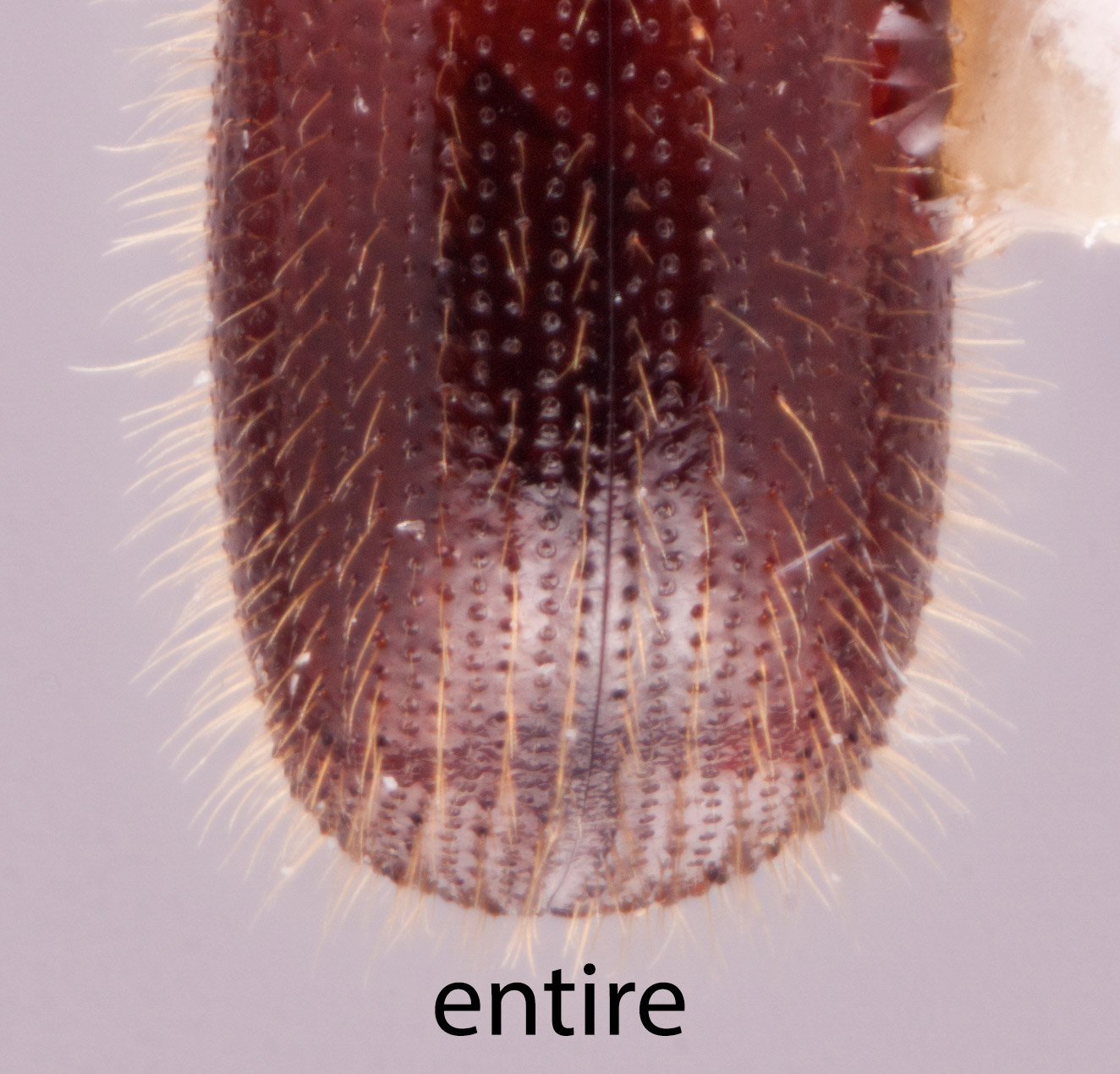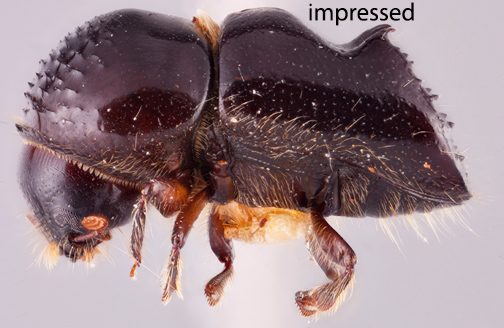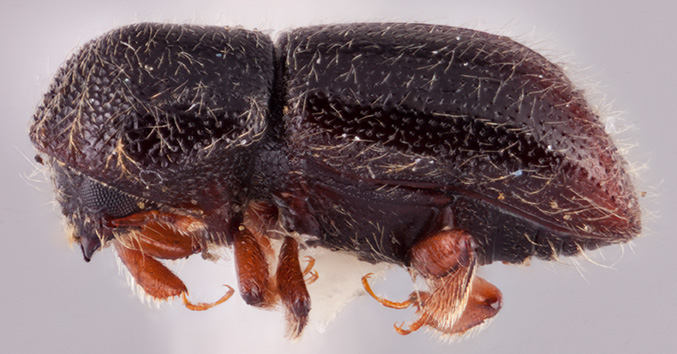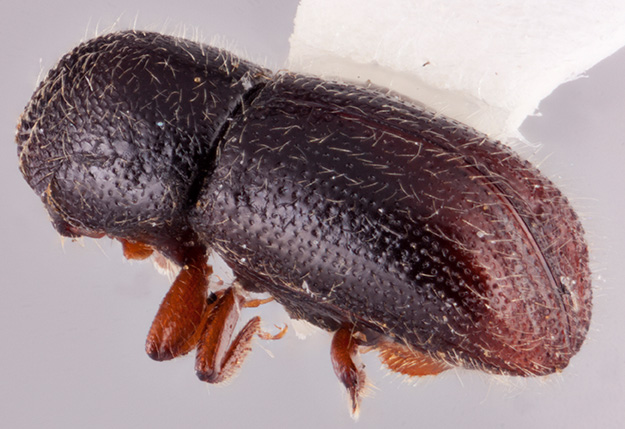Ambrosiophilus atratus
|
Ambrosiophilus atratus lateral; R.K. Osborn |
|
Ambrosiophilus atratus dorsal; R.K. Osborn |
|
Ambrosiophilus atratus declivity; R.K. Osborn |
|
Ambrosiophilus atratus frontal; R.K. Osborn |
Taxonomic history
Xyleborus atratus Eichhoff, 1876a: 201.
Ambrosiophilus atratus (Eichhoff): Hulcr and Cognato, 2009: 22.
Synonyms
Xyleborus collis Niisima, 1910: 12. Smith et al., 2018b: 392.
Diagnosis
3.3−3.5 mm long (mean = 3.46 mm; n = 5); 2.75−2.92 times as long as wide. This species can be distinguished by all declivitaldeclivital:
pertaining to the elytral declivity
interstriae granulategranulate:
pertaining to a coarse, grainy surface texture
 along the entireentire:
along the entireentire:
without marginal teeth or notches
 length; pronotumpronotum:
length; pronotumpronotum:
the dorsal surface of the thorax
from laterallateral:
pertaining to the side
 view long (type 8); declivitaldeclivital:
view long (type 8); declivitaldeclivital:
pertaining to the elytral declivity
striae 1 and 2 moderately to strongly impressedimpressed:
a depression in a surface
 ; interstriaeinterstria:
; interstriaeinterstria:
longitudinal spaces along the elytra between the striae, which is not as<br />
impressed and bear smaller punctures.
 moderately and uniformly granulategranulate:
moderately and uniformly granulategranulate:
pertaining to a coarse, grainy surface texture
 , granulesgranule:
, granulesgranule:
a small rounded protuberance, like grains of sand
 on interstriaeinterstria:
on interstriaeinterstria:
longitudinal spaces along the elytra between the striae, which is not as<br />
impressed and bear smaller punctures.
 3 spaced by a distance of 2−3 diameters of a granulegranule:
3 spaced by a distance of 2−3 diameters of a granulegranule:
a small rounded protuberance, like grains of sand
 ; interstrial setaeseta:
; interstrial setaeseta:
small hair-like or scale-like structure
long, hair-like; and large size.
May be confused with
Ambrosiophilus caliginestris, A. satoi, and A. sulcatus
Distribution
China (Chongqing, Fujian, Shanxi), Japan, South & North Korea, Taiwan. Introduced to Europe and North America (Atkinson et al. 1990; Faccoli 2008Faccoli 2008:
Faccoli M. 2008. First record of Xyleborus atratus Eichhoff from Europe with an illustrated key to the European Xyleborini (Coleoptera: Curculionidae: Scolytinae). Zootaxa 1772: 55-62. https://doi.org/10.11646/zootaxa.1772.1.2; Gomez et al. 2018aGomez et al. 2018a:
Gomez DF, Rabaglia RJ, Fairbanks KEO, Hulcr J. 2018a. North American Xyleborini north of Mexico: a review and key to genera and species (Coleoptera, Curculionidae, Scolytinae). ZooKeys 768: 19-68. https://doi.org/10.3897/zookeys.768.24697).
Host plants
polyphagous (Faccoli 2008Faccoli 2008:
Faccoli M. 2008. First record of Xyleborus atratus Eichhoff from Europe with an illustrated key to the European Xyleborini (Coleoptera: Curculionidae: Scolytinae). Zootaxa 1772: 55-62. https://doi.org/10.11646/zootaxa.1772.1.2, Beaver and Liu 2010Beaver and Liu 2010:
Beaver RA, Liu L-Y. 2010. An annotated synopsis of Taiwanese bark and ambrosia beetles, with new synonymy, new combinations and new records (Coleoptera: Curculionidae: Scolytinae). Zootaxa 2602: 1-47. https://doi.org/10.11646/zootaxa.2602.1.1)
Remarks
Kasson et al. (2016) have shown that the symbiotic association of the species with the fungus, Flavodon ambrosius, has allowed niche expansion with large, long-lived, interconnecting colonies, overlapping generations, and pre-dispersal oviposition by young females.
DNA data
Sequences available for COI and CAD.
COI: HM064120.1; OP617787
CAD: HM064298.1; OP607217





